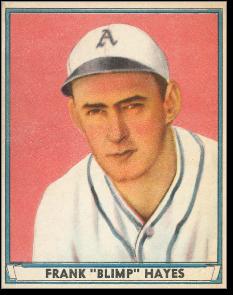
Frankie Hayes
Sport: Baseball
Born: October 13, 1914
Died: June 22, 1955
Town: Jamesburg, New Jersey
Franklin Witman Hayes was born October 13, 1914 in Jamesburg. Tall and athletic, he had the ideal build for a catcher of his era. Nevertheless, in the days before television, Frankie’s nickname “Blimp” led fans to believe he was an ungainly, waddling backstop. Frankie attended Jamesburg High School, and finished his education at Pennington
Prep. He excelled in baseball, basketball and football.
A bright young man with a talent for organization, Frankie put together a team in his hometown during the summer of 1933. An umpire working one of his games suggested to Connie Mack that he take a look at Frankie. Mack liked what he saw (Frankie drove five pitches in a row into the bleachers) and signed him at the age of 18. That fall he got into a handful of major-league games.
In 1934, Connie Mack sold Mickey Cochrane to the Tigers, leaving the catcher’s job wide open. Frankie split the job with veteran Charlie Berry, a fellow New Jerseyan known for his pro football heroics. The 19-year-old held his own behind the mask, but he was overwhelmed at the plate and Mack sent him to the minors to improve his offense in 1935. Before the demotion, however, Frankie accompanied a group of All-Stars on a tour of the Far East led by Mack and Babe Ruth, Frankie’s idol. Berry was originally scheduled to make the journey but came down with appendicitis.
Frankie returned in 1936 and held onto the regular catching job for the A’s until World War II. During this time he was considered one of baseball’s better defensive backstops. While his arm was not as powerful as others in the game, he gunned down his fair share of runners. In 1940, sportswriters voted him New Jersey’s best athlete.
This honor came on the heels of Frankie’s best year, 1939, when he belted 20 homers and batted .283. In 1940, he topped .300 for the first time. From 1939 to 1941, Frankie was a member of the American League All-Star team. He was also picked as an All-Star from 1944 to 1946, and was the starting catcher in the 1946 game.
During the war years, Frankie also played for the Browns, Tigers and Indians. In 1944, he returned to Philadelphia for a season and led the AL in games played—an almost inconceivable record for a catcher. It was part of a consecutive games played streak that stretched from the end of the 1943 season to the start of 1946—312 games in all, which still stands as a record more the 60 years later.
Frankie’s final year as a regular was 1946, which he split between the Indians and White Sox. He hit the ninth-inning homer against the Yankees that enable Bob Feller to beat New York with a no-hitter.
Frankie caught on with the Red Sox in 1947 but was released after a couple of months—ending his career as a player. Frankie retired with 1,194 hits, 119 homers, 628 RBIs and a career .259 average. He played 100 games or more as a catcher in seven different seasons, and came within a few games of that mark three other times.
Frankie lived in Freehold in his post-baseball years and owned a sporting goods store in Pt. Pleasant. In June of 1955, he checked himself into the hospital in Pt. Pleasant and never came out. The cause of his death was not revealed.
|